| Главная » Статьи » Униформа и знаки различия |
Dress Uniforms 1900-1915
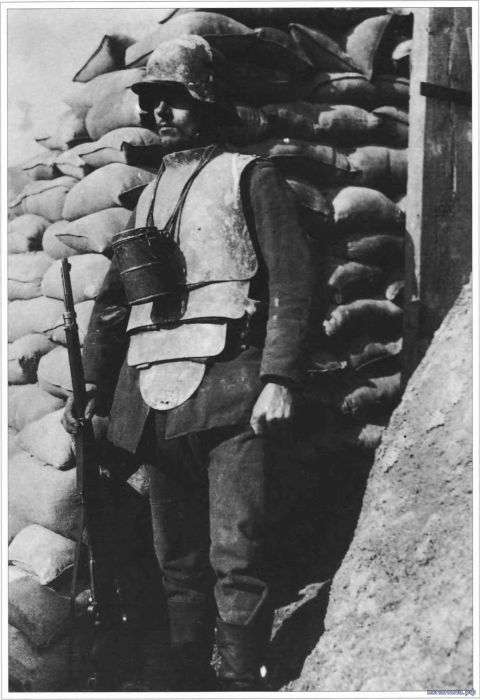 Infantry and Artillery In 1914, the Imperial German army had ceremonial uniforms as splendid as any in the world. With minor variations the infantry of the line and the Guards wore a single breasted Dunkelblau, or ‘dark blue’ jacket, with scarlet collar and cuffs. This was worn with blue-blacktrousers or Hosen, with a scarlet stripe down the outer seam of each leg. Senior regiments wore Litzen or decorative bars upon the collar. In summer (from the beginning of May to the end of September) the warm serge trousers were exchanged for a lighter type made of white linen. The dark trousers were often worn tucked inside die 1866 Model long marching boot, a practice which had been officially sanctioned since 1869, but there was also a black laced ankle boot which was worn with the summer trousers and in other orders of dress. The usual dress headgear was the famous Pickelhaube or ‘spiked helmet’ of polished black leather; many of the myriad state and other variations of which are described below. On other less formal occasions, a blue cloth peaked forage cap with a scarlet band and piping was worn. This piece of headgear was a private purchase item, but there was also a visorless version of the cap on issue. Additionally, an eighteenth century-style mitre cap was retained for ceremonial wear by certain elite infantry units, namely the 1 Garde-Regiment zu Fuji, the Kaiser Alexander Garde- Grenadier-Regiment Nr 1 and the palace guard company. These Grenadienniitze or grenadier caps had a body of scarlet felt with white facings, and were fronted by a large regimental plate. The 1 Garde- Regiment zu Fuji caps were further distinguished by a red and white pom pom and white metal chin scales and fittings; whilst the caps of the Kaiser Alexander regiment were decorated with a black and white pom pom and brass fittings. The palace guard wore the black and white pom pom and white metal fittings. Despite the antiquated appearance of the mitre cap the latest model had been sanctioned as recently as 1894. The main distinguishing feature of the dark blue uniform jacket or IVaJfenrock was its shoulder straps which bore regimental numbers or cyphers, and varied with colour according to the Army Corps to which the unit belonged. Scarlet shoulder straps were worn by III, IV, XI, XIII and XV Corps; and white by I, II, LX,xvn Corps; light blue by VII, Mil, XVIII and XX Corps; and light green by XXI Corps. Blue shoulder straps piped scarlet were worn by the XII, and XIX Saxon Corps. One Year volunteers also had a distinctive shoulder strap, edged by a twisted cord in the colours of their state. The main exception in terms of dress uniform in almost every7 respect were the Bavarian infantry, whose uniform was light blue with bright red facings, and scarlet shoulder straps in all of their three Corps. 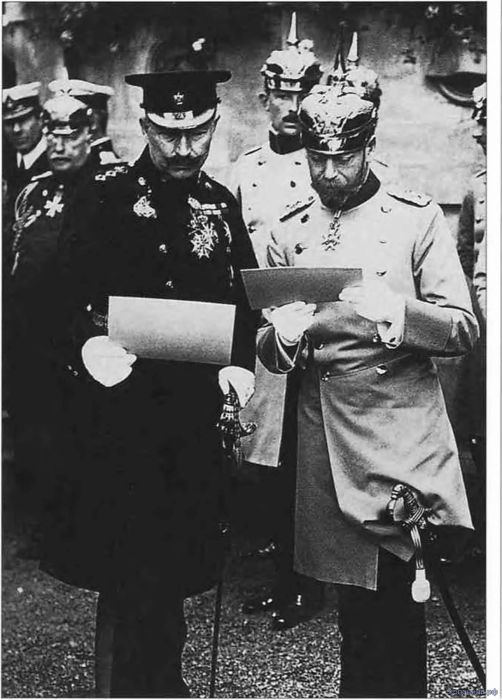 A highly unusual photograph showing the Kaiser and King George V during a pre-war official visit. The Kaiser, left, is wearing the undress uniform of the British 1st (Royal) Dragoons of which he was Colonel in Chief from 1894 to 1914. King George returns the courtesy, appearing in the undress uniform of a Prussian Guard regiment. The Jiiger infantry- battalions, or rifles, also wore a distinctive uniform of green with scarlet facings; the headgear being either a shako or a green peaked cap with a scarlet band and piping. For the majority of the Jiiger, the shako was of black leather, but die Saxons and the 108th Schiitzen regiment had a felt shako reinforced with leather. The Garde Schiitzen were differentiated by black facings piped in scarlet. The Jiiger legwear was again dark, almost black, trousers in winter; with white legwear for summer. Machine gun detachments were clad in a grey-green Waffenrock, with a shako of a similar colour reinforced with tan leather. Bavarian Jdgei’ and machine-gunners were again exceptions with a light blue uniform faced in green. What parts of the dress uniform were worn, and how, depended on the activity at hand. The four main orders of formal dress recognised in 1914 were Paradeanzug; Wachtanzug; Ordonnanzanzug; and Ausgehanzug. Paradeanzug, meaning literally ‘parade’ or ‘review’ costume, comprised the dress headgear with plumes if authorised for the unit; Waffenrock with orders and decorations, sidearms, belts, knots, rifle, pack and rolled greatcoat. All but musicians and standard bearers wore ammunition pouches. Wachtanzug, a stylised version of ‘watch’ or ‘guard’ dress was essentially the same but without the parade plumes or medals. In Ordonnanzanzug, or ‘orderly’ dress the pack and rifle and ammunition were 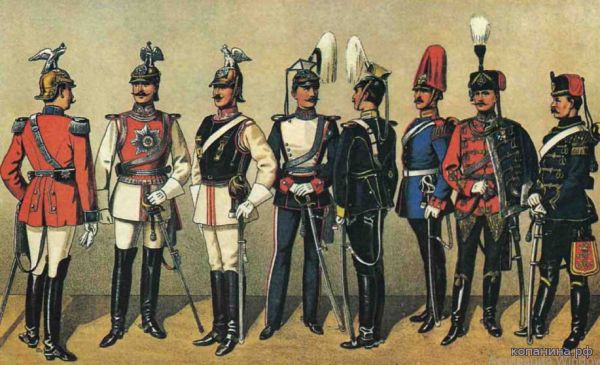 The uniforms of the Prussian Guard cavalry as depicted in the 1890s. Left to right: Garde Kurassier staff officer in court dress; Lieutenant Garde du Corps in ‘gala’ dress; Trooper Garde du Corps wearing the black cuirass; Garde Ulanen, officer Regiment Nr 1 and Trooper Regiment Nr 3; Guard Dragoon trumpeter; and Leib-Husaren, Lieutenant in court dress and staff trumpeter. From Nachtrage und Berichtigungen Zum Deutschen Reichsheer. dispensed with. The Ausgehanzug, the ‘going out’ or ‘walking out’ dress, featured the cap worn with the Waffenrock and trousers, belt, bayonet or sword, and knot. In addition to the formal Waffenrock most units possessed two other uniform jackets. The Litevka was effectively an undress jacket of grey or blue cloth with concealed buttons: its name was derived from the word Litarnn meaning smock. There was also a fatigue dress or Drillichanzug, of jacket and trousers, which was officially described as light grey, but was so light in tone that it was effectively off white. For the men the coat was short, somewhat shapeless, had a low stand up collar and six zinc buttons, and was worn without insignia; for non-commissioned officers the coat was more tailored and had a fitted waist seam and skirts. The Drillichanzug which was used extensively for duties such as digging, drilling, carrying stores and food preparation soon became dirty but unlike the other types of dress was easily washed. In winter or inclement weather, a grey greatcoat was worn by other ranks and a light grey greatcoat by officers, for mounted troops these coats were split up the back to make riding easier. The greatcoat was further differentiated by coloured collar patches, as for example red for infantry7 and Jager, red with yellow lace for Guard Jiiger, and black with yellow lace for Guard Schiitzen. Litzen and bars of lace to denote noncommissioned officers were also worn on the greatcoat collar patch. The 1901 model greatcoat was interesting in that it had a small hood attached under the collar, a feature dispensed with in the 1907 version. Officers also had a choice of other over garments; amongst them were the undress top coat or Ubeirock which was double-breasted and looser fitting than the Waffenrock-, the Paletot which was a light grey double- breasted coat worn for both sendee and parades; and the Mantel mit Unihang, a greatcoat with a cape. This last was not worn on parade, but off duty7, or when mounted in the field. Artillery dress uniforms were essentially similar to those of the infantry but there were a number of 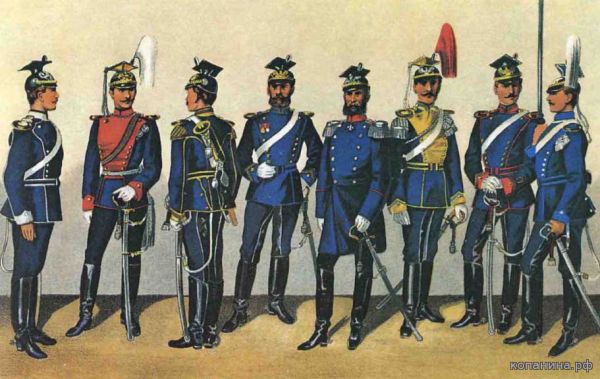 Prussian Lancer uniforms in the 1890s. Left to right: One Year volunteer Regiment Nr 13; Lieutenant Regiment Nr 3 in parade dress; trumpeter Regiment Nr 11; NCO Regiment Nr 12; Major, Regiment Nr 5; Staff trumpeter Regiment Nr 15 in parade dress; Farrier, Regiment Nr 14; and Trooper in parade dress Regiment Nr 16. From Nachtrage und Berichtigungen Zum Deutschen Reichsheer. distinguishing features. Perhaps the most obvious was that they wore not a spiked helmet, but a leather helmet with a ball fitting on the top. Shoulder straps also usually bore a flaming grenade in addition to a regimental number, cuff details also varied. Cavalry Cavalry dress uniforms were, if anything, more eye catching than those of the other services, with a gaudy plethora of colour and a mass of distinctions which can only be summarised here. The heavy Kiirassiere wore metal helmets and the Garde du Corps a black cuirass ior ceremonial. The dress uniform of the Kiirassiere was white, the various regiments being primarily distinguished by coloured facings thus: 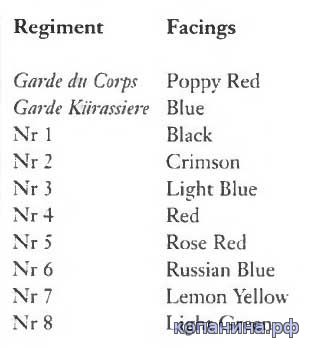 The Saxon Garde Reiter had white distinctions and the Saxon carabiner, black. The light blue jackets of the Bavaraian Sckwere Reiter had red facings. Amongst the most dramatic dress uniforms were those of the hussars, the lineage of some units of which stretched back to the eighteenth century. The basic short jacket of the other ranks of the hussars was the ‘Attila’, decorated with five rows of white or yellow woollen frogging to the front and a line of lace extending down the back on either side. The cuffs were ornamented with knots. In the case of officers the braid was of either silver or gold, agreeing with the colour worn by the men. The cloth of the Attila couldhe almost any colour of the rainbow, the hues of the 21 regiments being as follows, 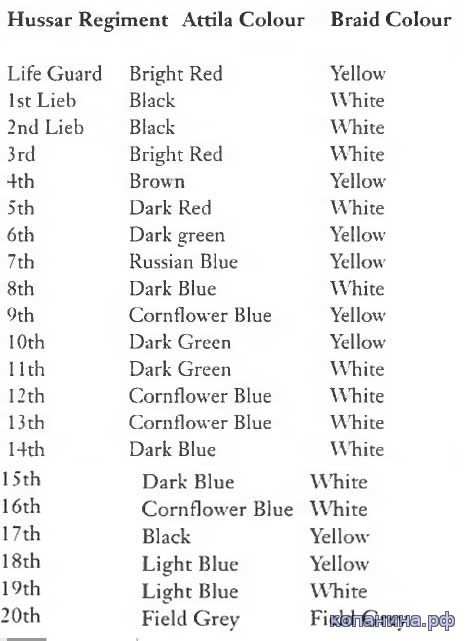 In many instances the spectacle was further enlivened by the fact that officers’ jackets were lighter in shade than those of the other ranks. In the 5 th Ffirst Blikher von Wahlstatt hussars for example the Attdla of the officers was more pink than red. In the 4th von Scbill (Silesian) hussars, the officers’ jacket was a reddish brown rather than the deep brown worn by the men. It was also the case that in certain orders of dress, officers were allowed the use of an undress tunic or ‘Interim Attila’: this garment was somewhat simpler than the full dress Attila lacking the rank lace on its collar and cuffs. Generally it was in the same colour as the Attila but the Life Guard hussars and the 3rd and 5th wore the Interim Attila in dark blue. Officers and other ranks were also permitted the use of a Litewka or grey working jacket. For other ranks, this was single-breasted and fly fronted, and for officers double-breasted with two row's of six buttons. Officers wore collar tabs, and other ranks collar patches, often in the colour of the Attila but as usual there were 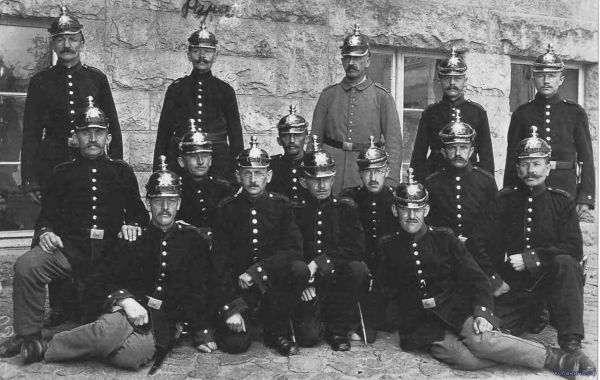 Men of the Dresden-based Sachsisches Feldartillerie- Regiment Nr 48, c 1913. All but one are wearing the blue dress uniform with flaming grenade and numerals in red on the shoulder strap. Note also the Kugelhelm with ball mount and the Saxon star helmet plate. 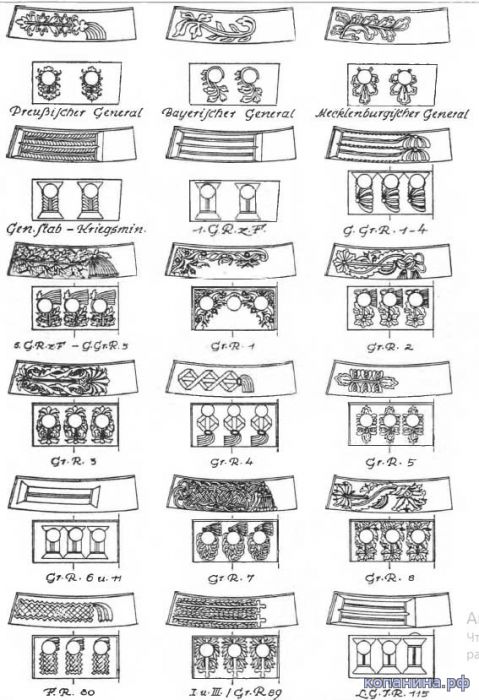 The distinctive types of lace and Litzen for various states and regiments. Notice in particular the difference between the collar lace of the generals of different states: Prussian, Bavarian and Mecklenburger variations. The main exceptions were the collar patches of the Life Guard hussars which had double yellow' Guard Litzen superimposed upon them; the 1 Oth which had deep pink patches; the 15th which had yellow' patches; the 18th which had red; and die 19th crimson. Not all regiments of hussars w'ere entitled to wear the Pelz or pelisse, the over jacket trimmed with fur, as this had been abolished in 1853, and only certain units had been reissued with it since - often as a gift from their colonel in chief. In all cases the fur trimmings for officers were light grey, but the colour of die cloth and colour of the fur for other ranks varied from regiment to regiment in the nine units that w'ore it: 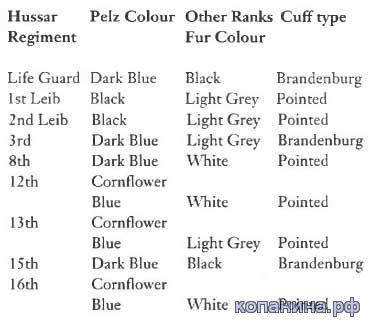 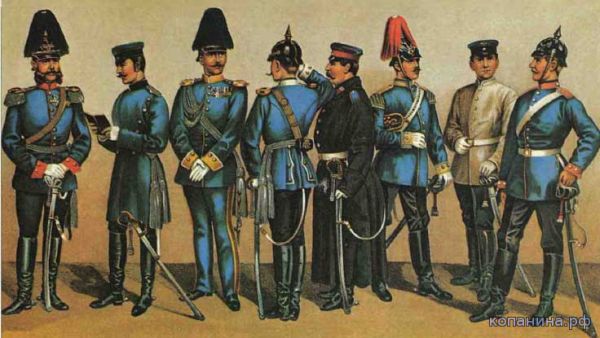 Prussian Dragoons, 1890s. Left to right: Regiment Nr 1, Lieutenant Colonel in parade dress; Regiment Nr 14, Adjutant; Regiment Nr 16 Captain in the uniform of a personal Adjutant to a Prince; Lieutenant Regiment Nr 9; NCO Regiment Nr 12; Regiment Nr 4, trumpeter in parade dress; NCO in fatigue dress Regiment Nr 2; One Year volunteer Regiment Nr 3. Hussars generally wore either blue black riding breeches or Reithosen, or during summer months white linen trousers. The exceptions to this general rule were the 18th and 19th regiments who wore light blue breeches and the 20th who wore field grey. The stripe down the outside of the legs of the breeches was yellow, white, gold or silver, depending on the lace colour of the regiment and whether the wearer was an officer or other rank. Additionally, general officers who wore hussar dress, and officers of the Life Guard hussars, were entitled to wear ‘gala’ breeches at balls and other dismounted special occasions. These breeches had elaborate lace decoration on the fronts of the thighs in silver or gold, and did not necessarily agree with the colour of either the Pelz or Attila. Thus it was that the gala breeches of the 6th and 7th were poppy red and the 10th deep pink. The dress headgear of the hussars was the busby or Pelzmiitze; which was also worn in the field, usually with a reed green cover. For other ranks the busby was a short, almost cylindrical, black sealskin hat with a field sign in the state colours to the front upper edge. The officers’ busby was taller and more voluminous and, until 1912 was of dark brown otter fur, a material which was then officially changed to grey opposum, but both types continued to be worn. Officers of the 17th wore a busby of black bearskin. Most busbies were fitted with a scroll in brass or white metal on which appeared the legend Mit Gottfiir Konig und Vaterland, meaning ‘With God for King and Fatherland’, but the 7th had only a ‘WR Г royal cypher and the Life Guard hussars and the Saxon regiments had stars. The 1st and 2nd Leib and the 17th 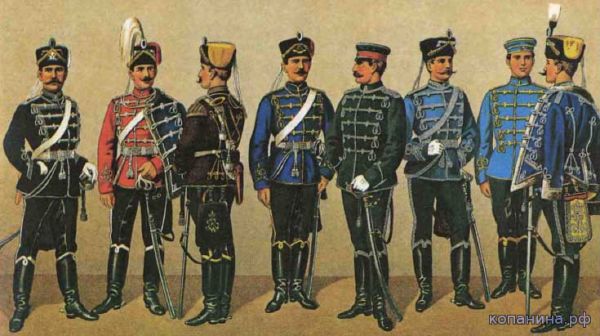 Prussian Hussars, 1890s. Left to right: NCO Leib-Husaren Regiment Nr 2; Hussar Regiment Nr 3, parade dress; Regiment Nr 4 trumpeter; Regiment Nr 7; Major, Regiment Nr 11; Lieutenant, Regiment Nr 12; Regiment Nr 9; Second Lieutenant Regiment Nr 15 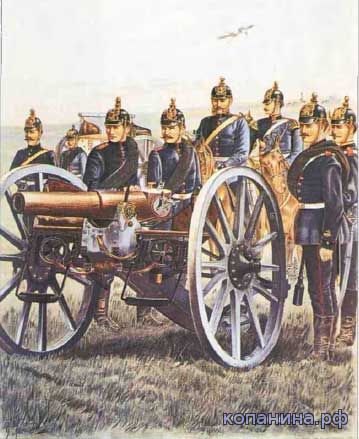 The Dunkelblau uniform of the 27th Nassau field artillery, as depicted c. 1900. 17th Brunswick were distinguished by a skull and crossbones badge. Beneath the right hand boss of the busby chin scales appeared a German national cockade in black, white and red. A further regimental distinction was the colourful cloth bag, worn on the left of the busby. For the Life Guard, 1st Leib, 3rd, 6th, 7th, 11th, 13th, 14th, 17th, and 18th the bag was red: white bags were worn by the 2nd Leib and 12th. Yellow was the bag colour for the 4th, 15th and 6th, whilst the 8th and 9th had bags of cornflower blue. For the 5th the colour was dark red; for the 10th deep pink; for the 19th crimson; and for the 20th light blue. The hussars’ alternative headgear, the undress capor Xliitze, was almost equally magnificent. For officers and senior non-commissioned officers the hat had a leather peak, none for the other ranks. The cap piping was in the colour of the regimental lace, and the crown of the cap was of the same colour as the Attila, but the cap band was of a contrasting colour. These colours were: dark blue for the Life Guard and 3rd; red for the 1st Leib, 6th, 7th, 11th, 13th, 14th and 17th; black for the 2nd Leib and 5th; brown for 4th; cornflower blue for the 8th, 9th and 12th; pink for the 18th, 19th and 20th. The lancer regiments or Ulanen may not have been quite so colourful as the hussars since all the Prussian and Wiirttemberg LJlans wore blue in full dress, the Bavarians green, and the Saxons light blue, yet there were several traditional features in their dress which singled them out. Perhaps the most obvious was the continued use of a rather exaggerated form of the Tscbapka, or square topped lance cap of Polish origin. This was of black laquered leather with a state badge on the skull section and, in full dress, a coloured cover on the upper part. The Ulan jacket or Ulanka was also of a distinctive pattern, being double-breasted, and having epaulettes with rounded ends rather than a plain shoulder strap and pointed cuffs. Perhaps surprisingly the tubular steel lance was not unique to the Ulanen, having been universally issued to the cavalry prior to 1914. On the march it was carried with its butt resting in a socket on the stirrup and held on the crook of die arm by means of a sling. It was decorated with a pennant in the provincial colours: black and white for Prussia; blue and white for Bavaria; green and white for Saxony and in the case of non-commissioned officers, it was adorned with an eagle or state arms. The main regimental differences to die full dress uniforms of the Ulanen were as follows: 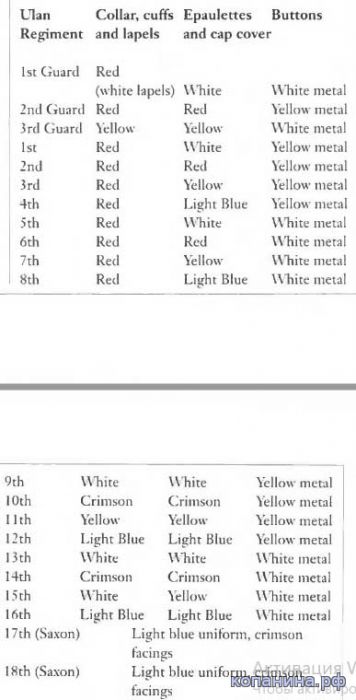 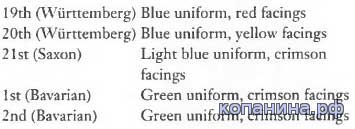 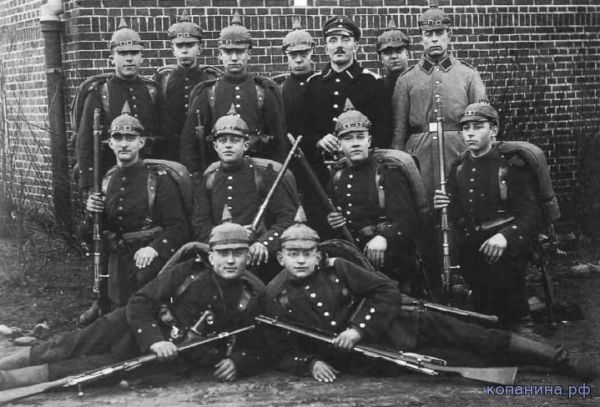 Pre-war recruits at the Lockstedter Lager camp near Neumiinster. The majority of the uniform is Dunkelblau, but grey Pickelhaube covers are worn; note the NCO with sword, peaked cap and lace on his coat collar. One man wears the grey greatcoat with the scarlet infantry collar patches. The rifles are obsolete G88 Mausers. 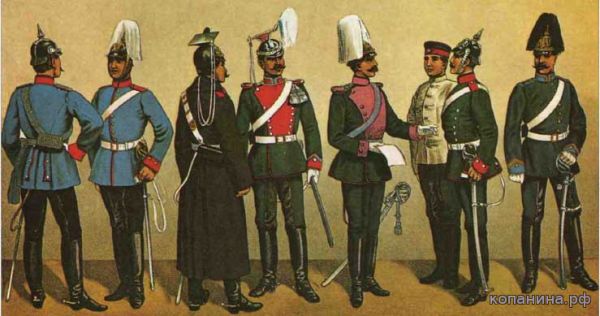 Bavarian Cavalry, 1890s. Left to right: Schwere-Reiter Regiment Nr 1, officer and Regiment Nr 2, Trooper in parade dress; Ulanen Regiment Nr 1 in greatcoat and Ulanen Regiment Nr 2, NCO; Chevauleger Regiment Nr 3, Lieutenant; Chevauleger Regiment Nr 1, Trooper in stable dress; Chevauleger Regiment Nr 4, Trooper in drill order; Riding School NCO The dragoon dress uniform was comparatively simple being a Pickelhaube worn with a cornflower blue Wajfenrock and dark blue overalls. The jacket had a standing collar which, together with the Swedish cuffs, was distinctly coloured. These regimental colours were: red for the Guards and regiments 1,5, 13, 17 and 20; black for 2, 6, 14, 18, 19 and 22; yellow for 4, 8, 16, 21 and 26; crimson for 11 and 12; pink for 3, 7 and 15 and white for 10 and 25. Hessian dragoons, like the Bavarian Chevauleger, were clad in green.The Jdger zu Pferde, literally ‘mounted rifles’, were the newest horsed units in the Imperial German army, the first three bodies of which were raised to the status of regiments as recently as 1905. By 1914, however, a further 10 had been embodied bringing the total number to 13. A distinction was retained between those units raised before 1913 and those numbered eight to 13 which were raised on 1st October 1913. The ‘old’ units numbered one to seven wore a Cuirassier style IVajfenrock whilst the jacket of the ‘new’ units was in the style of the dragoons. Although all the jackets were grey-green each regiment had its own facing colour: 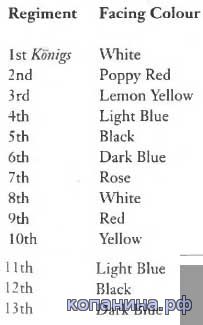 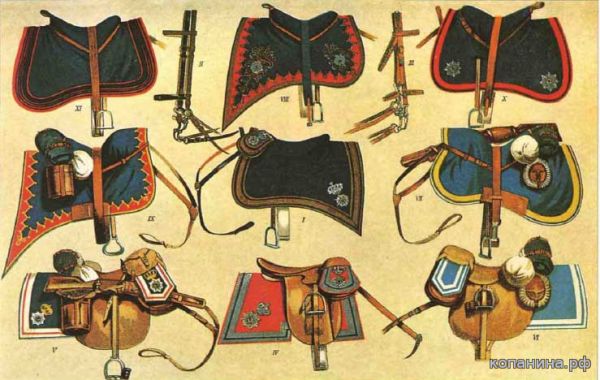 Prussian Horse Furniture, 1890s. I) General’s parade shabraque. II) General’s parade bridle. III) Cavalry officer’s bridle for all except Hussar officers. IV) Parade shabraque Garde du Corps officers. V) Service saddle and equipment Garde du Corps and Garde Kurassier. VI) Line Kurassier service saddle and equipment. VII) Service saddle and equipment for dragoons. VIII) Parade shabraque Leib-Husaren officers. IX) Service saddle and equipment, Hussars. X) Parade shabraque, officers of Ulanen Regiments. XI) Parade shabraque, line Feld Artillerie officers. Other ranks wore the unit’s regimental number on the dress uniform shoulder strap, but as Kaiser Wilhelm was the colonel in chief of the 1st these wore the cypher ‘WR IF in yellow or gilt instead. A Litewka style working jacket in light grey was worn by officers and also by other ranks of the first seven regiments.The officers’ Litrccka was double-breasted, the other ranks’ single-breasted and fly fronted. Both had light green collar patches. Officers could also wear a grey- green frock coat or ОЬатоск. Plain grev-green Reithosen or breeches were the usual mounted rifle legwear after 1911, though white gala trousers and black ‘walking out’ trousers for officers were not unknown. A differentiation between the old and new Jdger zu Pferde regiments was also maintained in the headgear. The first seven regiments all wore the Helm, or helmet, of blackened polished steel in cuirassier style. Fittings for this headgear were in silver for officers and white metal for other ranks. Officers were also allowed to purchase and wear an ‘extra helm’ of brightly polished steel. Though officers of regiments eight to 13 also wore the Helm, the other ranks of these formations wore a black leather Pickelhaube with fittings of yellow metal. | |
| Просмотров: 3879 | | |
| Всего комментариев: 0 | |